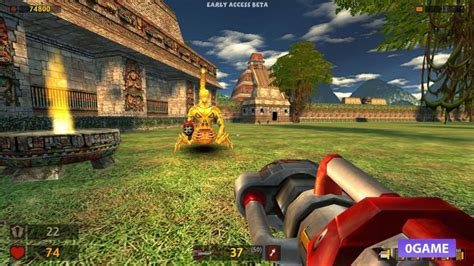In the world of online multiplayer gaming, few milestones are as notable as the advent of Serious Sam. This revolutionary game not only provided countless hours of fun but also brought incredible advancements in network coding. Despite the constraints of 56k modems, which were standard at the time, Serious Sam was able to handle a massive number of enemies on screen without significant latency issues. This was accomplished through a highly efficient and innovative network architecture, which many gamers and developers would argue set a precedent for future titles.
One key aspect that made Serious Sam stand out was its commitment to low latency and efficiency. As players traversed its chaotic and enemy-laden landscapes, the game maintained seamless performance. This was achieved by adopting a modified version of a ‘deterministic lockstep’ system, which minimized bandwidth usage—a crucial factor for 56k modem connections. The genius of this system lies in its simplicity: it synchronizes the game state by exchanging player input data between clients, rather than broadcasting full game states. This approach drastically reduced the amount of data that needed to be transmitted, ensuring smoother gameplay.
It is essential to understand the comparisons and distinctions made between Serious Sam and its predecessors like Doom and Quake. Doom’s networking strategies, which lockstepped animations and movements across clients, heavily influenced Serious Sam. Quake, on the other hand, adopted a different technique by sending updates about every entity a player could see. While this allowed for more complexity in scenes, it demanded significantly more bandwidth. The developers at Croteam opted for a Doom-style approach to tackle the game’s high scene complexity without overburdening the bandwidth. This decision not only catered to the current technology limits but also ensured a consistent and reliable gaming experience.
The conversation on Hacker News sheds light on the profound impact of Serious Sam’s network coding. Developers and players reminisced about the game’s groundbreaking achievements and how it still influences modern gaming. One particularly interesting comment from a former developer involved in Serious Sam’s netcode revealed that evenings were often spent tinkering and testing after hours, inspired by posts about QuakeWorld’s prediction system on Usenet. The collaborative and iterative nature of their work speaks to the dedication and passion that went into optimizing Serious Sam for real-time multiplayer action.
Another point of interest is how deterministic simulations prevent certain types of cheats that are possible in state synchronization netcode models. In a deterministic simulation, every client has complete world data, requiring them to agree on the game state at every step, minimizing discrepancies and ensuring fair play. However, this also means that if any client falls out of sync, the game could crash due to ‘desync’ errors. The architecture Croteam employed for Serious Sam thus required meticulous attention to detail to ensure consistent simulation across different hardware platforms.
Serious Sam’s ability to run smoothly even on less powerful hardware is another testament to its efficient design. As some players remarked nostalgically, Serious Sam not only held its own during LAN parties but often became the go-to game when other contemporary titles failed to perform due to driver or hardware issues. The simplicity and reliability of Serious Sam’s engine contributed significantly to its longevity and popularity. In an era where hardware limitations could easily hinder gameplay, Serious Sam provided a consistently enjoyable experience.
The game’s sound design also left a lasting impression on players. The shrill scream of the beheaded kamikazes, getting louder as they approached, created an immersive and nerve-wracking atmosphere that many gamers still remember vividly. Such attention to audio detail not only enhanced the overall gaming experience but also showcased the importance of sound in creating memorable and impactful gameplay moments. Reflecting on similar sound design techniques from other beloved titles like Half-Life and Left 4 Dead, it becomes evident how integral sound can be to a game’s success and its legacy.
Despite its age, Serious Sam’s network architecture remains relevant and influential. Modern games, although equipped with more advanced technology, often struggle to deliver the same level of efficiency and smoothness that Serious Sam achieved on much more restrictive systems. The lessons learned from Serious Sam’s development continue to be valuable for game developers today. Emphasizing efficiency, low latency, and reliability are principles that transcend generations of technology and remain as crucial now as they were during the era of 56k modems.


Leave a Reply